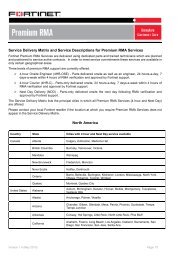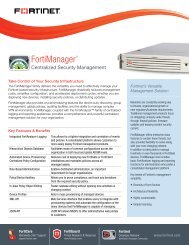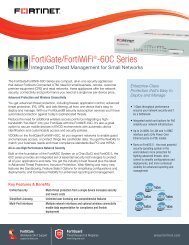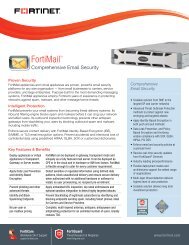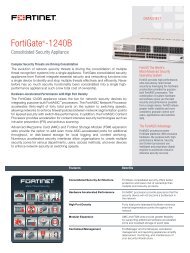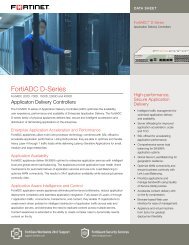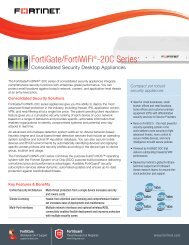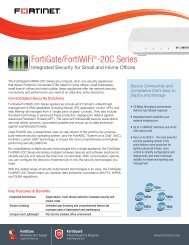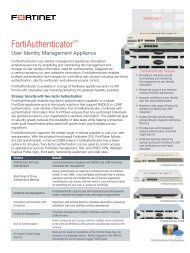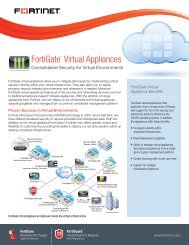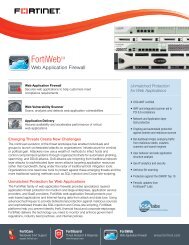FortiWeb and the OWASP Top 10 - Unified Communications ...
FortiWeb and the OWASP Top 10 - Unified Communications ...
FortiWeb and the OWASP Top 10 - Unified Communications ...
Create successful ePaper yourself
Turn your PDF publications into a flip-book with our unique Google optimized e-Paper software.
FORTINET – <strong>FortiWeb</strong> <strong>and</strong> <strong>the</strong> <strong>OWASP</strong> <strong>Top</strong> <strong>10</strong><br />
Mitigating <strong>the</strong> most dangerous application security threats<br />
PAGE 5<br />
Figure 6 <strong>FortiWeb</strong>’s Vulnerability Scanner<br />
Page Access <strong>and</strong> Start Page Enforcement<br />
Enforcing access to <strong>the</strong> application according to <strong>the</strong> correct business logic is an important part of web application<br />
security. Applications that do not enforce this open <strong>the</strong>mselves to Cross Site Request Forgery (CSRF) attacks. For<br />
example, e-commerce applications should not allow access to <strong>the</strong> shipping or payments stage directly, without prior<br />
access to <strong>the</strong> ordering pages.<br />
By defining a Page Access rule on <strong>FortiWeb</strong> CSRF attacks are immediately blocked helping with <strong>OWASP</strong> <strong>Top</strong> Ten A5<br />
requirement.<br />
Additionally, <strong>FortiWeb</strong> offers a Start Page policy as well which defines <strong>the</strong> entry point to <strong>the</strong> application helping with<br />
requests that try to circumvent au<strong>the</strong>ntication or any o<strong>the</strong>r environment that requires users to start browsing at a specific<br />
page.<br />
<strong>OWASP</strong> <strong>Top</strong> Ten <strong>and</strong> <strong>FortiWeb</strong> Mitigation Technique<br />
The table below lists <strong>the</strong> <strong>OWASP</strong> <strong>Top</strong> Ten <strong>and</strong> <strong>the</strong> corresponding <strong>FortiWeb</strong> mitigation techniques.<br />
<strong>OWASP</strong> <strong>Top</strong> <strong>10</strong> Explanation <strong>FortiWeb</strong> Mitigation<br />
A1. Injection Injection flaws, such as SQL, OS, <strong>and</strong> LDAP<br />
injection, occur when untrusted data is sent to<br />
an interpreter as part of a comm<strong>and</strong> or query.<br />
The attacker’s hostile data can trick <strong>the</strong><br />
interpreter into executing unintended<br />
comm<strong>and</strong>s or accessing unauthorized data.<br />
Auto-Learn profiling automatically builds<br />
an allowed baseline allowing a<br />
comprehensive request validation<br />
feature to enforce strict URL <strong>and</strong><br />
parameter control. Enhanced application<br />
signature detection engine adds a<br />
secondary layer for abnormal characters<br />
<strong>and</strong> known injection strings.<br />
A2. Cross-Site Scripting<br />
(XSS)<br />
XSS flaws occur whenever an application takes<br />
untrusted data <strong>and</strong> sends it to a web browser<br />
without proper validation <strong>and</strong> escaping. XSS<br />
allows attackers to execute scripts in <strong>the</strong><br />
victim’s browser which can hijack user sessions,<br />
deface web sites, or redirect <strong>the</strong> user to<br />
malicious sites.<br />
Application signature detection engine<br />
includes various XSS signatures. Request<br />
validation process ensures only relevant<br />
characters can be submitted.




